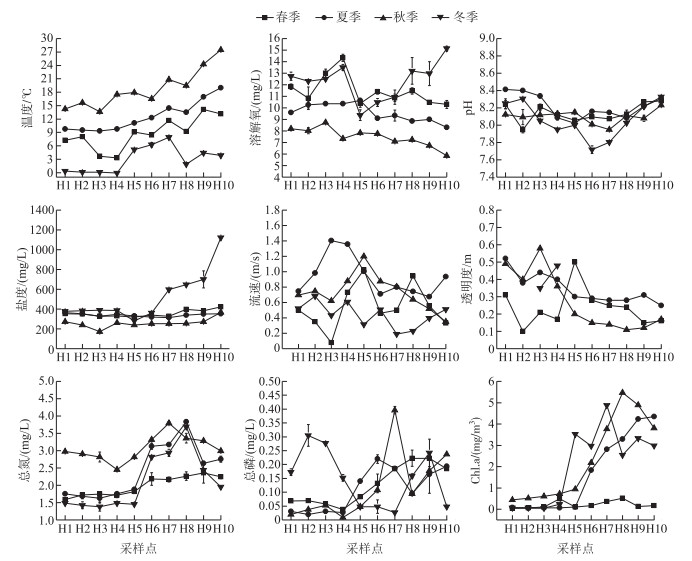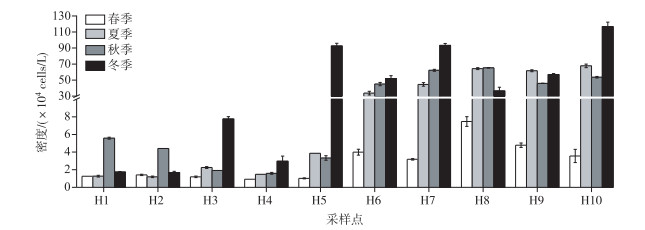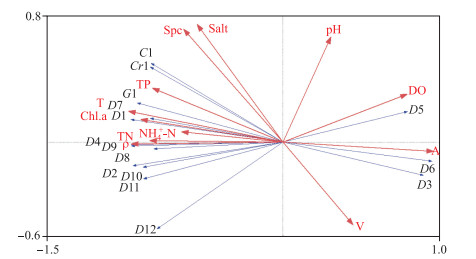浮游植物是水生态系统的初级生产者,是水体食物链和食物网的基础环节,在物质循环和能量流动过程中起着重要作用,其组成和多样性变化直接影响着水生态系统的结构与功能.水体中营养盐、温度、pH和光照等环境因子的改变会直接影响浮游植物的生物量和群落结构[1-3],尤其在水体富营养化程度不断加重时,会直接导致环境敏感型种类消亡,浮游植物多样性降低[4].因此,浮游植物已成为水体监测及水生态健康评价的重要指标,在国内外被广泛应用[5-6].在我国,针对河流浮游植物研究及水环境监测和评价主要集中在长江流域[7-8]、珠江流域[9]、淮河流域[10-11]和东北地区[12-13],而在内陆地区较为少见.
黑河是我国第二大内陆河,发源于青海省祁连县,北流进入甘肃张掖,最后注入内蒙古居延海,全长821 km,流域面积14.29万km2.流域受中高纬度西北风带环流控制和极地冷气团影响,形成了干燥、寒冷、多大风、日照时间长、昼夜温差大的极端气候类型[14].从上游到下游,黑河依次穿越了高山冰雪冻土带、山区植被带、绿洲带、下游荒漠带4个气候带,形成了黑河特有的复合生态系统[15].黑河水资源的开发利用主要集中在人口最为密集的张掖段,因此,此河段土地沙化与盐碱化、水环境污染等问题一直非常突出[16-18].近年来,黑河流域水资源严重短缺,水体污染不断加重,脆弱的水生态环境受到严重干扰[19].目前,有关黑河流域浮游植物的研究仅有零星报道[19-21, 14],尤其从时空变化角度来探讨黑河浮游植物群落结构及其与水质关系的相关研究尚处于空白,因此,本研究对黑河张掖段浮游植物群落结构和环境因子的季节时空变化规律进行分析,在对水质进行评价的基础上,运用冗余分析(redundancy analysis, RDA)与Pearson相关性分析揭示黑河张掖段浮游植物种类组成和现存量与环境因子之间的相关关系,为黑河环境监测及水生态保护提供基础数据资料.
1 材料与方法 1.1 采样点设置黑河张掖段上游到下游依次可分为祁连山区、绿洲农业区和荒漠-盐碱地区,共设10个点(图 1),分别为H1(三道湾)、H2(二龙山)、H3(大孤山)、H4(小孤山)、H5(张掖黑河大桥)、H6(板桥镇)、H7(平川黑河大桥)、H8(高台黑河大桥)、H9(罗城黑河大桥)和H10(正义峡).采样断面位置与海拔(A)见表 1.

|
图 1 黑河张掖段采样点分布 Fig.1 Distribution of sampling sites in Zhangye section of Heihe River |
| 表 1 黑河张掖段采样断面信息 Tab. 1 Sampling segments information of Zhangye section of Heihe River |
于2017年3月、6月、9月中旬和11月底进行采样,分别代表 4个季度调查浮游植物现存量.用25#浮游生物网采集表层水样并立即用Lugol溶液固定,用于定性分析.定量样品的采集使用5 L有机玻璃采水器分别于河流左、中、右岸采集水样,并盛入桶中混匀后取1 L水样,立即加入Lugol溶液进行固定,带回实验室静置48 h后,用虹吸管移去上清液浓缩至30 ml.计数时,将浓缩液充分混匀后立即取0.1 ml于浮游植物计数框计数,藻类的鉴定参考《中国淡水藻类》、《中国淡水藻类志》等[22-24].
1.3 水体理化指标的测定现场使用YSI(美国,YSI ProPlus)测定水温(T)、pH、溶解氧(DO)浓度、电导率(Spc)、盐度(Sal)等参数,透明度使用塞式盘法测定,流速(V)使用旋杯式流速仪测定.总氮(TN)、总磷(TP)、叶绿素a(Chl.a)、铵态氮(NH4+-N)浓度等指标的测定参照(《水与废水监测分析方法(第四版)》)[25].
1.4 多样性指数及优势度的计算 1.4.1 多样性指数Shannon-Wiener多样性指数(H′)的计算公式为:
| $ H' = - \sum\limits_{i = 1}^s {{p_i}\ln } {p_i} $ | (1) |
Pielou均匀度指数(E)的计算公式为:
| $ E = \frac{{H'}}{{\ln \;S}} $ | (2) |
Margalef指数(d)的计算公式为:
| $ d = \left( {S - 1} \right)/\ln \;N $ | (3) |
式中,N为总个体数,pi为第i个种类密度与总密度的比值,S为藻类的属数.
1.4.2 优势度Manaughton优势度指数Y的计算公式为:
| $ Y = \frac{{{N_i}}}{N}{f_i} $ | (4) |
式中,Ni为样品中某藻数量,N为采集样品中浮游植物总数量,fi为样品中某浮游植物出现的频率.当物种Y>0.02时,该种即为优势种群[26].
1.5 数据处理所有数据通过Excel软件整理,使用SPSS13.0进行显著性和Pearson相关性分析,使用Origin9.0软件作图,用CANOCO 4.5软件进行RDA分析, 分析浮游植物的种类组成与环境因子之间的相关关系.对种群信息进行去趋势对应分析(DCA),排序轴梯度长度(LGA)均小于3,因此选择基于线性RDA分析,相关显著性用Monte Carlo法进行检验.为使浮游植物的个体数和环境因子的数据获得正态分布,除pH值外均进行lg(x+1)转换.
2 结果分析 2.1 黑河张掖段水环境因子时空变化调查期间黑河张掖段4个季度水体温度变化规律为:秋季>夏季>春季>冬季,年均值为10.89℃,年变化范围为-0.1℃~27.46℃,方差分析结果表明,4个季度温度差异显著(P<0.05);夏、秋季DO浓度变化幅度较小,平均值分别为9.58和7.48 mg/L,春、冬季则变化幅度较大,从上游到下游呈现“N”型变化趋势,平均值分别为11.48和12.31 mg/L,均显著高于夏、秋季(P<0.05);pH年变化幅度在7.71~8.41之间,年变化幅度较小,方差分析结果表明,pH差异不显著(P>0.05);盐度在春、夏、秋季较为平稳,平均值分别为350、330和260 mg/L,但在冬季H7~H10断面显著升高(P<0.05),最高值达1120 mg/L;流速大小为夏季(0.93 m/s)>秋季(0.73 m/s)>春季(0.54 m/s)>冬季(0.43 m/s);受汛期的影响,黑河春、夏、秋季水体均浑浊,尤其是下游荒漠区,水土流失较严重,水体泥沙含量较高,因而透明度较低,而冬季大部分断面水体清澈见底;TN浓度变化范围为1.38~4.45 mg/L,从上游到下游总体呈现逐渐升高的趋势,方差分析发现秋季TN浓度显著高于其他3个季节(P<0.05);TP浓度在0.009~0.396 mg/L之间,冬季波动较大,其他3个季节则从上游到下游呈逐渐升高的趋势;Chl.a浓度在春季变化幅度不大(0.04~0.51 mg/m3之间),但其他3个季节则从上游到下游随着海拔的降低而显著增加(P<0.05),呈“J”型,最大值出现在秋季H8断面,为5.4 mg/m3(图 2).

|
图 2 黑河张掖段水体物理指标季节变化 Fig.2 Seasonal changes of water quality indicators in Zhangye section of Heihe River |
2017年度,黑河张掖段共计检出浮游植物8门80属316种.其中蓝藻门种类34种,占总种类数的10.75 %;绿藻门种类48种,占比为15.22 %;硅藻门种类216种,占比为68.35 %;裸藻门和甲藻门种类各6种,各占总种类数的1.89 %;隐藻门种类4种,占总种类数的1.26 %;金藻门和黄藻门种类各1种,各占总种类数的0.32 %.
2.3 浮游植物密度及优势种调查期间,黑河张掖段浮游植物密度(ρ)在0.92×104~116.67×104 cells/L之间,从上游到下游呈现明显的递增趋势.从时间角度来看,冬季平均密度最高,为46.20×104 cells/L,其次为夏、秋季,浮游植物密度平均值分别为28.20×104和28.89×104 cells/L,春季密度最低,为2.87×104 cells/L(图 3).

|
图 3 黑河张掖段各断面不同季节浮游植物密度 Fig.3 Density of phytoplankton in different seasons of each station in Zhangye section of Heihe River |
黑河张掖段优势种主要集中在硅藻门,个别断面优势种中出现蓝藻门、绿藻门和隐藻门种类.其中硅藻门延长等片藻细弱变种、尖针杆藻、简单舟形藻、谷皮菱形藻是分布于整个河段的优势种,从河段上游至下游,延长等片藻细弱变种Y值呈现降低趋势,而简单舟形藻和谷皮菱形藻Y值则呈倒“V”型分布.扇形藻、弧形峨眉藻、极小曲壳藻则主要为祁连山区H1~H4断面优势种,变异直链藻、普通等片藻、肘状针杆藻则主要在下游绿洲农业区至荒漠区H6~H10断面占据优势.值得注意的是,在夏季H9~H10断面优势种类群中,微囊藻的Y值达到0.025以上,同样在冬季,尖尾蓝隐藻和卵形隐藻也在H7断面成为主要优势种,Y值分别为0.045和0.032(表 2).
| 表 2 黑河张掖段浮游植物优势种及其优势度 Tab. 2 Dominant species and dominance degree of phytoplankton in Zhangye section of Heihe River |
黑河张掖段4个季度H′均值分别为2.65、2.76、2.89和2.44,E的均值分别为0.93、0.90、0.91和0.87,d的均值分别为1.73、1.77、2.00和1.31.随着海拔降低,黑河张掖段浮游植物H′和d均呈现增加的趋势,而E变化则相对平稳(图 4). Pearson分析结果(表 3)表明,H′与TN浓度、Chl.a浓度、温度和总藻密度呈极显著正相关,与海拔呈极显著负相关(P<0.01),相关系数分别为0.870、0.881、0.791、0.887和-0.902;d与TN浓度、TP浓度、Chl.a浓度、温度和总藻密度呈极显著正相关,与海拔呈极显著负相关(P<0.01),相关系数分别为0.808、0.766、0.937、0.825、0.960和-0.940;与前两者不同的是,E与所有环境因子均无显著相关性(P>0.05).

|
图 4 黑河张掖段浮游植物多样性指数、丰富度指数及均匀度指数 Fig.4 Diversity index, richness and evenness index of phytoplankton in Zhangye section of Heihe River |
| 表 3 黑河张掖段浮游植物密度与环境指标的相关性矩阵 Tab. 3 Correlation matrix of phytoplankton on cell density and environmental indicators in the Zhangye section of Heihe River |
对黑河张掖段浮游植物与环境因子的RDA分析结果(图 5)表明,所选环境因子共解释了92.4 %的物种变化信息,其中轴Ⅰ和轴Ⅱ的特征值分别为0.771和0.089,累积解释了86 %的物种变化信息.硅藻门种类包括普通等片藻、尖针杆藻、肘状针杆藻、极小曲壳藻、简单舟形藻、谷皮菱形藻和尖端菱形藻与TN浓度呈正相关,与海拔高度和DO浓度呈负相关,四尾栅藻、微囊藻和变异直链藻与温度、TP浓度、Sal、Spc呈正相关,与流速呈负相关;高山冷水型硅藻扇形藻和弧形峨眉藻则与海拔、DO浓度呈正相关.

|
图 5 浮游植物与环境因子的RDA双轴排序图 (C1:微囊藻(Microcystis sp.),G1:四尾栅藻(S. quadricauda),Cr1:尖尾蓝隐藻(C. acuta),D1:变异直链藻(M. varans),D2:普通等片藻(D. vulgare),D3:延长等片藻细弱变种(D. elongatum var. tenuis),D4:尖针杆藻(S. acus),D5:弧形峨眉藻(C. arcus),D6:扇形藻(Meridium sp.),D7:肘状针杆藻(S. ulna),D8:极小曲壳藻(A. minutissima),D9:简单舟形藻(N. simplex),D10:小型舟形藻(N. minuscula),D11:谷皮菱形藻(N. palea),D12:尖端菱形藻(N. acula)) Fig.5 RDA ordination biplot between phytoplankton species and environmental factors |
对浮游植物密度与环境指标Pearson相关分析结果表明(表 3),浮游植物密度与TP浓度、Chl.a浓度和温度呈极显著正相关(P<0.01),与海拔呈极显著负相关(P<0.01),与TN浓度、Spc和盐度呈显著正相关(P<0.05),与DO浓度呈显著负相关(P<0.05).可以看出,影响黑河张掖段浮游植物的环境因子较为复杂.
3 讨论浮游植物物种组成和群落结构受水体营养盐浓度、水动力学特征、浮游动物觅食压力、水文动态的直接作用[27],除此之外,时间与地理空间变化的影响也不容忽视[28].本年度调查共检出浮游植物316种,其中硅藻门种类占比达68.35 %,且在数量上占据优势.无论从浮游植物种类组成还是密度来看,黑河张掖段浮游植物群落均表现出明显的空间趋异特征.这些趋异特征与黑河本身的气候、地理特征和受污染状况密切相关. 1990s末,李鹏等对黑河流域张掖境内的10个断面调查发现,黑河流域浮游植物地理分布具有与河流水文分带相对应的垂直地理性分异[14];郝媛媛等在黑河全流域共发现242种浮游植物,浮游植物种类组成和丰度都均存在明显的空间差异性[21].从上游到下游,随着海拔降低,浮游植物种类数和密度均逐渐增加,优势种由高山冷水型的峨眉藻、扇形藻等逐渐过渡为尖针杆藻、普通等片藻、变异直链藻和肘状针杆藻等普生性种类.但值得引起关注的是,延长等片藻细弱变种和谷皮菱形藻作为优势种出现频率达到100 %,且在不同河段占据优势地位;同时下游H6~H10断面优势种中有蓝藻门微囊藻、绿藻门四尾栅藻以及隐藻门卵形隐藻和尖尾蓝隐藻出现.研究表明,谷皮菱形藻、尖针杆藻和舟形藻都是α中污带的指示种[29],隐藻、微囊藻是中富营养—重富营养水体的代表种类[30],其在河段下游不同程度占据优势地位,暗示了黑河张掖段水质存在一定程度的污染,在河段中游区污染程度呈加剧状态.
水生态系统中,环境变化必然会导致浮游植物群落结构和优势种的变化[31-32],而多样性指数常被用来评判水体浮游植物群落现状及水污染状况. H′反映环境变化对藻类群落的影响,环境敏感型藻类的消失会导致浮游植物群落结构趋于简单,稳定性下降[33-34]. E是实际多样性指数与理论最大多样性指数的比值,反映物种个体数目分配的均匀程度[35]. d反映浮游植物群落与环境间的关系,d越大,所指示的环境越稳定[36]. 2017年度,黑河张掖段H′变化范围为1.26~3.68,年均值为2.68;E在0.51~1.08之间变化,年均值为0.91;d变化范围为0.92~2.80,年均值为1.70.从河段上游到下游,随着海拔的降低,黑河张掖段H′和d均呈现升高的趋势,而E值变化范围相对平稳.这表明上游祁连山区断面浮游植物多样性较低,群落结构相对较简单且稳定性较差,而中下游断面则多样性较高,群落结构渐趋复杂且稳定性较高,这与前人研究结果相类似[14, 21].但与前两者不同的是,E与海拔无显著相关性(P>0.05),表明整个黑河张掖段浮游植物物种分布相对均匀,种群分散程度大,群落结构较为稳定.根据多样性指数对水质的评价分级标准进行总体评价[32],黑河张掖段水质呈无污染或轻度污染到轻中度污染.
一般认为,水体氮磷营养盐[37]、温度[38]、溶解氧[39]、电导率[40]等环境因子可以直接影响浮游植物的群落组成、细胞密度、生命周期及分布等[41],但营养盐浓度更多的被认为是显著影响浮游植物生长与组成的关键因子[42],丰富的营养盐常使得普生性浮游植物大量繁殖[43].先前对黑河张掖段水质评价发现,上游水质较好,但下游由于工业、农业和生活污水排入导致水质污染较严重[44-46].本研究发现类似结果,即2017年度,张掖段TN浓度在1.38~4.45 mg/L之间,TP浓度在0.009~0.396 mg/L之间,且二者均呈从上游到下游逐渐增加的趋势. Pearson分析结果表明,黑河张掖段浮游植物总密度分别与TN和TP浓度呈显著(P<0.05)和极显著相关(P<0.01),同时,RDA分析结果也发现,TN浓度与优势种分布呈正相关.可见,TN、TP浓度是影响黑河张掖段浮游植物分布的主要环境因子.郝媛媛等研究发现黑河流域中游段浮游植物丰度与水体理化因子无显著相关性[21],然而,本研究结果则相反.笔者认为,黑河水源补给主要为祁连山冰雪融水,从上游到下游穿越不同气候带,形成了特有的复合生态系统[15].仅在张掖境内,就包括祁连山区、中游绿洲农业区和下游盐碱地—荒漠区3种类型,因此,即使在相对较小的时空尺度内,不同地理格局条件下的氮、磷及其他水环境因子的趋异特征依然是影响浮游植物优势种分布及密度大小的关键因素. Pearson分析结果发现,黑河张掖段浮游植物密度与温度相关系数达0.928,呈极显著相关(P<0.01),与Spc和Sal呈显著正相关(P<0.05),与DO浓度呈显著负相关(P<0.05). RDA分析也发现,下游优势种微囊藻、尖尾蓝隐藻、四尾栅藻和变异直链藻与温度、Sal、Spc呈正相关.赵颖研究藻类比生长速率与温度的关系,发现稳固在25~35℃之间时藻比生长速率逐渐升高,25℃为藻类生长繁殖的最佳温度条件[47];而喜低温生长的硅藻在急水流、水体交换量大、电导率高、水体较硬的环境下种类较丰富,并占据优势[48-49];谭啸等发现,较高的水温能促进浮游植物的生长并使蓝藻形成优势[50],隐藻门种类则适宜在较低温度环境中生长[51].整个年度,黑河张掖段优势种主要为硅藻门种类占据绝对优势,但秋季随着温度不断升高,微囊藻、四尾栅藻密度不断增加并成为优势种,冬季低温阶段隐藻门种类优势度不断增加,说明水温亦是决定浮游植物群落动态的关键因子.受盐碱地影响,冬季枯水期时,黑河下游水体Spc和Sal急剧升高,使得半咸水种类具有更加适宜的生长环境.
4 结论1) 黑河张掖段共检出浮游植物316种,硅藻门种类全年占据绝对优势,此外,在河段中下游断面优势种中也有蓝藻门的微囊藻、绿藻门的四尾栅藻和隐藻门的卵形隐藻、尖尾蓝隐藻出现.
2) 结合水体营养盐指标、浮游植物及多样性指数等指标对水质评价,黑河张掖段水质总体呈无污染或轻度污染到轻中度污染,在河段中游区污染程度呈加剧状态,值得引起相关部门注意.
3) RDA与Pearson相关性分析结果表明,水体氮磷营养盐、温度、海拔是影响黑河张掖段浮游植物群落动态的关键因子.在河段下游受盐碱地的影响,电导率和盐度也是影响浮游植物群落结构的主要环境因子.
| [1] |
Reynolds CS, Irish AE. Modelling phytoplankton dynamics in lakes and reservoirs:the problem of in-situ growth rates. Hydrobiologia, 1997, 349(1/2/3): 5-17. |
| [2] |
Marchetto A, Padedda BM, Mariani MA et al. A numerical index for evaluating phytoplankton response to changes in nutrient levels in deep Mediterranean reservoirs. Journal of Limnology, 2009, 68(1): 106-121. DOI:10.4081/jlimnol.2009.106 |
| [3] |
Li QH, Han BP. Structure and dynamics of phytoplankton community based CCA analysis in a pumped storage reservoir. Acta Ecologica Sinica, 2007, 27(6): 2355-2364. [李秋华, 韩博平. 基于CCA的典型调水水库浮游植物群落动态特征分析. 生态学报, 2007, 27(6): 2355-2364. DOI:10.3321/j.issn:1000-0933.2007.06.027] |
| [4] |
Zhang JF, Feng J, Xie SL et al. Characteristics of phytoplankton community structures in Ningwu subalpine lakes, Shanxi Province. J Lake Sci, 2012, 24(1): 117-122. [张俊芳, 冯佳, 谢树莲等. 山西宁武亚高山湖群浮游植物群落结构特征. 湖泊科学, 2012, 24(1): 117-122. DOI:10.18307/2012.0116] |
| [5] |
Kerans BL, Karr JR. A benthic index of biotic integrity (B-IBI) for rivers of the Tennessee Valley. Ecological Applications, 1994, 4(4): 768-785. DOI:10.2307/1942007 |
| [6] |
Wu HJ, Ren JH, Lu YY. A community ordination of phytoplankton and ecological assessment of water quality of lakes in Wuhan. J Lakes Sci, 2007, 19(1): 87-91. [邬红娟, 任江红, 卢媛媛. 武汉市湖泊浮游植物群落排序及水质生态评价. 湖泊科学, 2007, 19(1): 87-91. DOI:10.18307/2007.0113] |
| [7] |
Yang H, Zeng B, Sun XY et al. Effect of impoundment on community structure of the phytoplankton in the main stream of the Three Gorges Reservoir of Chongqing. Acta Hydrobiology Sinica, 2012, 36(4): 715-723. [杨浩, 曾波, 孙晓燕等. 蓄水对三峡库区重庆段长江干流浮游植物群落结构的影响. 水生生物学报, 2012, 36(4): 715-723.] |
| [8] |
Zhu AM, Hu JX, Li SX et al. Phytoplankton diversity and water quality in the main stream and tributaries of Three Gorges Reservoir region of Yangtze River during dry season. J Lake Sci, 2013, 25(3): 378-385. [朱爱民, 胡菊香, 李嗣新等. 三峡水库长江干流及其支流枯水期浮游植物多样性与水质. 湖泊科学, 2013, 25(3): 378-385. DOI:10.18307/2013.0311] |
| [9] |
Tian SM, Yang Y, Qiao YM et al. Temporal and spatial distribution of phytoplankton chlorophyll-a and its relationships with environmental factors in Dongjiang River, Pearl River basin. J Lake Sci, 2015, 27(1): 31-37. [田时弥, 杨扬, 乔永民等. 珠江流域东江干流浮游植物叶绿素a时空分布及与环境因子的关系. 湖泊科学, 2015, 27(1): 31-37. DOI:10.18307/2015.0104] |
| [10] |
Zhu WJ, Pang WT, You QM et al. Phytoplankton community structure and the evaluation of water quality in spring, Huaihe River Basin. J Lake Sci, 2017, 29(3): 637-645. [朱为菊, 庞婉婷, 尤庆敏等. 淮河流域春季浮游植物群落结构特征及其水质评价. 湖泊科学, 2017, 29(3): 637-645. DOI:10.18307/2017.0312] |
| [11] |
Qiu YL, Lin YQ, Liu JJ et al. The biodiversity assessment of phytoplankton community in summer within main stream and tributary of Huaihe River. Acta Scientiae Circumstantiae, 2018, 38(4): 1665-1672. [邱阳凌, 林育青, 刘俊杰等. 淮河干流及主要支流夏季浮游植物群落生物多样性评价. 环境科学学报, 2018, 38(4): 1665-1672.] |
| [12] |
Li QN, Zhao W, Yin XW et al. Phytoplankton diversity in Taizi River tributary in Liao River. Journal of Dalian Ocean University, 2011, 26(4): 322-327. [李庆南, 赵文, 殷旭旺等. 辽河太子河水系的浮游植物种类多样性研究. 大连海洋大学学报, 2011, 26(4): 322-327. DOI:10.3969/j.issn.1000-9957.2011.04.007] |
| [13] |
Li Z, Jiang ZF, Huo TB et al. Dynamics of phytoplankton diversity and water quality evaluation in the middle reaches of Heilongjiang River. Journal of Fishery Science of China, 2012, 19(4): 671-678. [李喆, 姜作发, 霍堂斌等. 黑龙江中游浮游植物多样性动态变化及水质评价. 中国水产科学, 2012, 19(4): 671-678.] |
| [14] |
Li P, An LZ, Feng HY et al. Study on geographical distribution characteristic of phytoplankton in the Heihe valley. Acta Bot Boreal-Occident Sin, 2001, 21(5): 966-972. [李鹏, 安黎哲, 冯虎元等. 黑河流域浮游植物及其地理分布特征研究. 西北植物学报, 2001, 21(5): 966-972. DOI:10.3321/j.issn:1000-4025.2001.05.022] |
| [15] |
Cheng GD. Study on the integrated management of water-ecology-economic system in Heihe River basin. Beijing: Science Press, 2009. [程国栋. 黑河流域水-生态-经济系统综合管理研究. 北京: 科学出版社, 2009.]
|
| [16] |
Lan YC, Sun BM, Ding YJ et al. Studies on ecological environment changes of Heihe River Basin and its influence factors. Journal of Arid Land Resources and Environment, 2004, 18(2): 32-39. [蓝永超, 孙保沐, 丁永建等. 黑河流域生态环境变化及其影响因素分析. 干旱区资源与环境, 2004, 18(2): 32-39. DOI:10.3969/j.issn.1003-7578.2004.02.007] |
| [17] |
Feng JP. Study on the mass control of aquatic environment pollution drainage in Zhangye Reach of the Heihe River valley[Dissertation]. Yangling: Northwest Sci-Tech University of Agriculture, 2004. [冯金鹏.黑河流域张掖段水环境污染物排放总量控制研究[学位论文].杨凌: 西北农林科技大学, 2004. http://www.wanfangdata.com.cn/details/detail.do?_type=degree&id=Y641363 ]
|
| [18] |
Li H. Water quality assessment and trend analysis in the Black River Basin[Dissertation]. Lanzhou: Lanzhou University of Technology, 2014. [李慧.黑河流域水质评价及变化趋势分析[学位论文].兰州: 兰州理工大学, 2014. http://cdmd.cnki.com.cn/Article/CDMD-10731-1014264933.htm ]
|
| [19] |
Lan YC, Kang ES, Zhang JS et al. Study on the water resources and its rational development and utilization in Heihe River basin. Journal of Lanzhou University:National Sciences, 2002, 38(5): 108-114. [蓝永超, 康尔泗, 张济世等. 黑河流域水资源合理开发利用研究. 兰州大学学报:自然科学版, 2002, 38(5): 108-114.] |
| [20] |
Yang SQ, Chen TR, Ke X et al. Characteristics of phytoplankton community structure in Zhangye National Wetland Park. Journal of Biology, 2017, 34(6): 51-55. [杨宋琪, 陈天仁, 克选等. 张掖国家湿地公园浮游植物群落结构特征. 生物学杂志, 2017, 34(6): 51-55. DOI:10.3969/j.issn.2095-1736.2017.06.051] |
| [21] |
Hao YY, Sun GJ, Zhang LX et al. Relationship between community characteristics of the phytoplankton and environmental factors in Heihe River basin. J Lake Sci, 2014, 26(1): 121-130. [郝媛媛, 孙国钧, 张立勋等. 黑河流域浮游植物群落特征与环境因子的关系. 湖泊科学, 2014, 26(1): 121-130. DOI:10.18307/2014.0115] |
| [22] |
Hu HJ, Wei YX. The freshwater algae of China:Systematics, taxonomy and ecology. Beijing: Science Press, 2006. [胡鸿钧, 魏印心. 中国淡水藻类——系统, 分类及生态. 北京: 科学出版社, 2006.]
|
| [23] |
Zhang Q, Liu GX, Hu ZY. Study on freshwater genus Phridiniopsis(Dinophyta) From China. Acta Hydrobiologica Sinica, 2012, 36(4): 751-764. [张琪, 刘国祥, 胡征宇. 中国淡水拟多甲藻属研究. 水生生物学报, 2012, 36(4): 751-764.] |
| [24] |
Zhu HZ, Chen JY. Bacillariophyta of the Xizang Plateau. Beijing: Science Press, 2000. [朱惠忠, 陈嘉佑. 中国西藏硅藻. 北京: 科学出版社, 2000.]
|
| [25] |
"Monitoring and analysis method of water and wastewater" editorial board of State Environmental Protection Administration of China. Monitoring and analysis methods of water and wastewater:fourth edition. Beijing: China Environmental Science Press, 2002. [国家环境保护总局《水和废水监测分析方法》编委会. 水和废水监测分析方法:第4版. 北京: 中国环境科学出版社, 2002.]
|
| [26] |
Lampitt RS, Wishner KF, Turley CM et al. Marine snow studies in the Northeast Atlantic Ocean:distribution, composition and role as a food source for migrating plankton. Marine Biology, 1993, 116(4): 689-702. |
| [27] |
Reynolds CS. The ecology of phytoplankton. Cambridge University Press, 2006.
|
| [28] |
Stomp M, Huisman J, Mittelbach GG et al. Large-scale biodiversity patterns in freshwater phytoplankton. Ecology, 2011, 92(11): 2096. DOI:10.1890/10-1023.1 |
| [29] |
Kuang QJ, Ma PM, Hu ZY et al. Stuey on the evaluation and treatment of lake eutrophication by means of algae biology. Journal of Safety and Environment, 2005, 5(2): 87-91. [况琪军, 马沛明, 胡征宇等. 湖泊富营养化的藻类生物学评价与治理研究进展. 安全与环境学报, 2005, 5(2): 87-91. DOI:10.3969/j.issn.1009-6094.2005.02.024] |
| [30] |
Hu HJ, Li YY, Wei YX et al. The freshwater algae of China. Shanghai: Shanghai Scientific & Technical Publishers, 1981. [胡鸿钧, 李尧英, 魏印心等. 中国淡水藻类. 上海: 上海科学技术出版社, 1981.]
|
| [31] |
Li H, Liu Y, Fan YW et al. Community structure characteristics of phytoplankton in Tongjiang of the Sanjiang Plain Wetland. Chinese Bulletin of Botany, 2014, 49(4): 440-449. [李慧, 刘妍, 范亚文等. 三江平原湿地同江地区水域夏季浮游植物群落结构特征. 植物学报, 2014, 49(4): 440-449.] |
| [32] |
Ouyang H, Han BP. Water quality and phytoplankton community in the Qiyeshi Reservoir after water diversion from Dongjiang river. J Lake Sci, 2007, 19(2): 204-211. [欧阳昊, 韩博平. 从东江调水后契爷石水库的水质和浮游植物群落结构特征. 湖泊科学, 2007, 19(2): 204-211. DOI:10.18307/2007.0215] |
| [33] |
Gao X, Song J. Phytoplankton distributions and their relationship with the environment in the Changjiang Estuary, China. Marine Pollution Bulletin, 2005, 50(3): 327-335. DOI:10.1016/j.marpolbul.2004.11.004 |
| [34] |
Longuethiggins MS. On the Shannon-Weaver index of diversity, in relation to the distribution of species in bird censuses. Theoretical Population Biology, 1971, 2(3): 271-289. DOI:10.1016/0040-5809(71)90020-7 |
| [35] |
Sun J, Liu D. The application of diversity indices in marine phytoplankton studies. Acta Oceanologica Sinica, 2004, 26(1): 62-75. |
| [36] |
Margalef DR. Information theory in ecology. General Systems, 1958, 3: 36-71. |
| [37] |
Hai X, Paerl HW, Qin BQ et al. Nitrogen and phosphorus inputs control phytoplankton growth in eutrophic Lake Taihu, China. Limnology & Oceanography, 2010, 55(1): 420-432. |
| [38] |
Cai HJ, Chen YW, Cai QM et al. Relations between primary production of phytoplankton and relative factors at mouth of Meiliang Bay in Taihu Lake. J Lake Sci, 1994, 6(4): 340-347. [蔡后建, 陈宇伟, 蔡启铭等. 太湖梅梁湾口浮游植物初级生产力及其相关因素关系的研究. 湖泊科学, 1994, 6(4): 340-347. DOI:10.18307/1994.0407] |
| [39] |
Kunlasak K, Chitmanat C, Whangchai N et al. Relationships of dissolved oxygen with chlorophyll-a and phytoplankton composition in Tilapia ponds. International Journal of Geosciences, 2013, 4(5): 46-53. DOI:10.4236/ijg.2013.45B008 |
| [40] |
Wang H, Yang SP, Fang SZ et al. Canonical correspondence analysis of relationship between characteristics of phytoplankton community and environment factors in Dianchi Lake. China Environmental Science, 2016, 36(2): 544-552. [王华, 杨树平, 房晟忠等. 滇池浮游植物群落特征及与环境因子的典范对应分析. 中国环境科学, 2016, 36(2): 544-552. DOI:10.3969/j.issn.1000-6923.2016.02.034] |
| [41] |
Lv J, Wu HJ, Ma XL et al. Canonical correspondence analysis between Cyanophyta and environmental factors for lakes in Wuhan. Ecology and Environment, 2008, 17(2): 515-519. [吕晋, 邬红娟, 马学礼等. 武汉市湖泊蓝藻分布影响因子分析. 生态环境, 2008, 17(2): 515-519. DOI:10.3969/j.issn.1674-5906.2008.02.011] |
| [42] |
Kong FX, Gao G. Hypothesis on Cyanobacteria bloom-forming mechanism in large shallow eutrophic lakes. Acta Ecologica Sinica, 2005, 25(3): 589-595. [孔繁翔, 高光. 大型浅水富营养化湖泊中蓝藻水华形成机理的思考. 生态学报, 2005, 25(3): 589-595. DOI:10.3321/j.issn:1000-0933.2005.03.028] |
| [43] |
Bernhard AE, Peele ER. Nitrogen limitation of phytoplankton in a shallow embayment in northern Puget Sound. Estuaries, 1997, 20(4): 759-769. DOI:10.2307/1352249 |
| [44] |
Wang GX, Cheng GD. Changes of hydrology and ecological environment during late 50 years in Heihe River Basin. Journal of Desert Research, 1998, 18(3): 233-238. [王根绪, 程国栋. 近50a来黑河流域水文及生态环境的变化. 中国沙漠, 1998, 18(3): 233-238. DOI:10.3321/j.issn:1000-694X.1998.03.008] |
| [45] |
Xie ZP, Li L, Gen XJ et al. Heihe River by Protozoa evaluation of the quality of Zhangye. Environmental Monitoring in China, 2009, 25(2): 35-38. [谢宗平, 李莉, 耿晓杰等. 用原生动物评价黑河张掖段水质. 中国环境监测, 2009, 25(2): 35-38. DOI:10.3969/j.issn.1002-6002.2009.02.011] |
| [46] |
Wang GX, Cheng GD, Qian J et al. N and P loading features and dynamical changes in arid inland water bodies of northwest China. Advance in Earth Science, 2003, 18(3): 338-344. |
| [47] |
Zhao Y. Study on effect of hydrometeorological element on algae growth[Dissertation]. Nanjing: Hohai University, 2006. [赵颖.水文、气象因子对藻类生长影响作用的试验研究[学位论文].南京: 河海大学, 2006. http://cdmd.cnki.com.cn/Article/CDMD-10294-2006077278.htm ]
|
| [48] |
Fott B ed. Translated by Luo Di'an. Algenkunde. Shanghai: Shanghai Science and Technology Press, 1980: 392-394. [福迪B.罗迪安译.藻类学.上海: 上海科学技术出版社, 1980: 392-394. ]
|
| [49] |
Hu JL, Liu GX, Cai QH et al. Investigation on the phytoplankton of spring from the Three Gorges Reservoir in Chongqing. Acta Hydrobiologica Sinica, 2006, 30(1): 116-119. [胡建林, 刘国祥, 蔡庆华等. 三峡库区重庆段主要支流春季浮游植物调查. 水生生物学报, 2006, 30(1): 116-119. DOI:10.3321/j.issn:1000-3207.2006.01.022] |
| [50] |
Tan X, Kong FX, Yu Y et al. Effects of enhanced temperature on algae recruitment and phytoplankton community succession. China Environmental, 2009, 29(6): 578-582. [谭啸, 孔繁翔, 于洋等. 升温过程对藻类复苏和群落演替的影响. 中国环境科学, 2009, 29(6): 578-582. DOI:10.3321/j.issn:1000-6923.2009.06.004] |
| [51] |
Santos ACAD, Calijuri MC. Survival strategies of some species of the phytoplankton community in the Barra Bonita Reservoir (São Paulo, Brazil). Hydrobiologia, 1998, 367(1/2/3): 139-151. |
 2019, Vol. 31
2019, Vol. 31 

